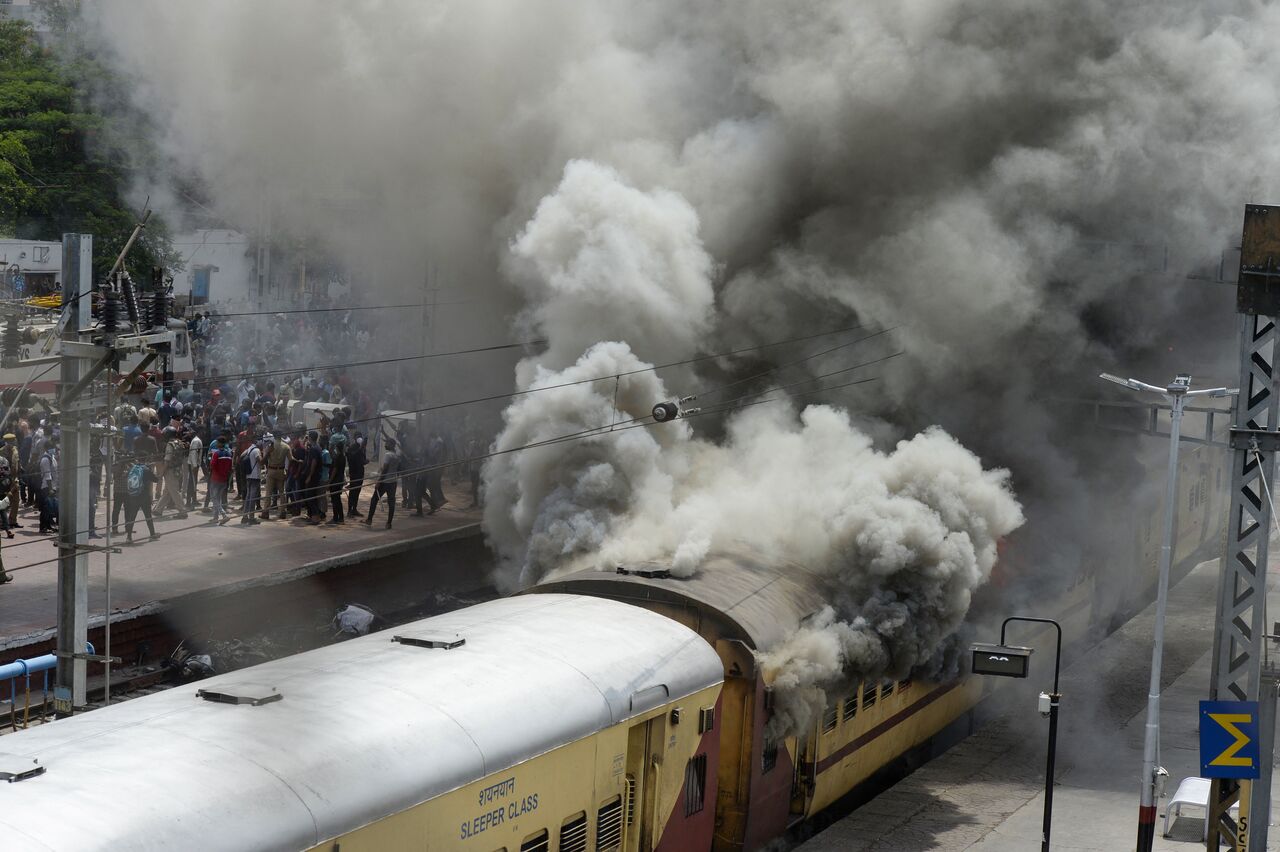Indian new military hiring policy triggers violent protests by unemployed youth
Sign up now: Get insights on Asia's fast-moving developments

Protesters setting a train on fire during a demonstration against the government's new 'Agnipath' recruitment scheme for the military in Secunderabad, India, on June 17, 2022.
PHOTO: AFP
Follow topic:
KOLKATA - Angry youth desperate for long-term stable government jobs continued their violent protests for the third day in a row in several Indian states against a new recruitment policy that has trimmed the service period for fresh recruits in the country’s armed forces.
This worrying fallout accentuates the underlying job crisis in India’s economy that has failed to provide its youth with adequate employment opportunities.
Demanding a rollback of the scheme announced this week, protesters torched trains and buses, blocked railway tracks and clashed with security forces. At least one person was killed on Friday and over a dozen were injured when police shot live rounds at a crowd that set fire to passenger trains in the state of Telangana.
Under the scheme named Agnipath (Path of Fire), those aged between 17.5 and 21 will be recruited as soldiers below officer rank for a four-year contract.
They will receive a monthly salary of between 30,000 to 40,000 rupees (S$532 to S$710) and will not be entitled to pension or gratuity benefits accorded to ex-soldiers hired earlier on regular recruitment terms.
One-fourth of the 46,000 taken in this year under this policy will, however, be retained for another 15 years on regular terms.
The scheme is an attempt by the government to build a younger and fitter force that is technologically more adept, while reducing its pension burden and diverting funds to modernise the armed forces.
Under previous rules, those aged between 16.5 and 21 years were recruited as soldiers at the lowest ranks for at least 15 years and received pension after retirement.
The Indian armed forces, which employ around 1.4 million in a nation of 1.4 billion people, is one of the world’s biggest employers along with the country’s railways.
There has, however, been no recruitment into the force during the past two years and many young Indians are desperate to get in before the cutoff age.
In response to the protests, the government on Thursday raised the Agnipath scheme’s upper age limit to 23 for this year.
One of the many youths protesting is Mr Guddu Kumar Yadav, a 20-year-old from Arrah district in Bihar. He has been training for the past two years to get into the Indian Army, putting himself through an arduous regimen of long-distance running and high jumps, among other exercises.
“It has been my dream to get into the army,” he told The Straits Times. With hardly any job options in the state but for scarce government ones, Mr Yadav said the new scheme will leave youths such as him in a lurch.
“What are we going to do once we return home after four years? We are not even going to get a pension,” he added. “The government will train us to use weapons but does it want us to use them later to become terrorists?”

The government has said those completing their four-year stint will receive a tax-free payout of around 1.17 million rupees to make them “financially empowered”. This amount, however, includes a 30 per cent contribution from the individual’s salary, matched equally by the government.
Around 64 per cent of India’s population is aged between 15 and 59, creating intense competition for lucrative government jobs in a country with inadequate employment opportunities in the private sector.
It is not uncommon to have hundreds compete for a single public sector opening with even postgraduates applying for low-skilled jobs that require only those who have studied till grade 10.
India’s unemployment rate for urban areas was 8.2 per cent in the first quarter of this year. However, the unemployment rate for youth (aged 15 to 29) in urban areas has hovered at more than 20 per cent for the past several quarters.
The government earlier this week also sought to address the job crisis by announcing it would recruit one million people over the next one-and-a-half years.

